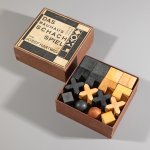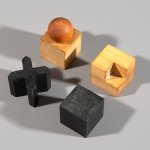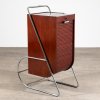Lot: 393
Josef Hartwig
Bauhaus - Chess Set Model XVI
Designed in 1924. Manufactured at the Bauhaus in Weimar. Maple wood, partially stained black. Cardboard covered with paper. 32 figures. H. 2.1–4.7 cm. Cardboard: H. 5.2 x 12.4 x 12.4 cm. Designed by Joost Schmidt, 1923/24.
Reserve price: 5,000 €
10. May 2025 at 10:00 AM CEST
Literature:
Provenance: originally owned by the graphic artist Ruth Krüger-Pauly, who was friends with Otto Dix and others and collaborated with the Bauhaus around 1930. The chess set was a gift to her at the time and survived her escape from the East in a handcart in 1945. Inherited by inheritance to the current owner. Josef Hartwig's chess set is one of the most successful products designed at the Weimar Bauhaus. In 1922, the graduate of the Munich Academy, who worked as foreman in the wood and sculpture workshops at the Weimar Bauhaus from 1921 to 1925, began designing a chess set that was fundamentally different from traditional forms. Hartwig designed the playing pieces from simple stereometric bodies: cube, cylinder, and sphere. Initially, the pieces were handcrafted, but the goal was industrial production. Hartwig himself explained the genesis of the shapes in 1924: "The pawn and rook move at right angles to the edge of the board: expressed by the die. The knight moves at right angles in a hook shape on four squares: four dice combined at right angles. The bishop moves diagonally to the edge of the board: a diagonal cross cut out of the die. The king moves at right angles and diagonally: a small die across a larger one. The queen, the most mobile piece, consists of a cylinder and a sphere." (The Bauhaus Chess Set by Josef Hartwig, p. 8). Bauhaus-Archiv Berlin, Das Bauhaus-Schachspiel von Josef Hartwig, Berlin 2006, p. 19; Hahn, Experiment Bauhaus, Dessau 1988, p. 401; Bauhaus-Archiv, collection catalog, Berlin 1987, pp. 149-50, cat. no. 288; exh. cat. Bauhaus 7, Galerie am Sachsenplatz, Leipzig 1991, ill. p. 43, cat. no. 134.
Read our Terms & Conditions.








